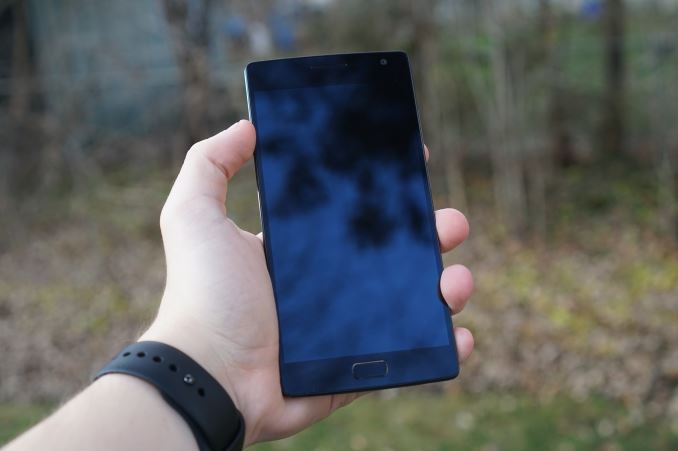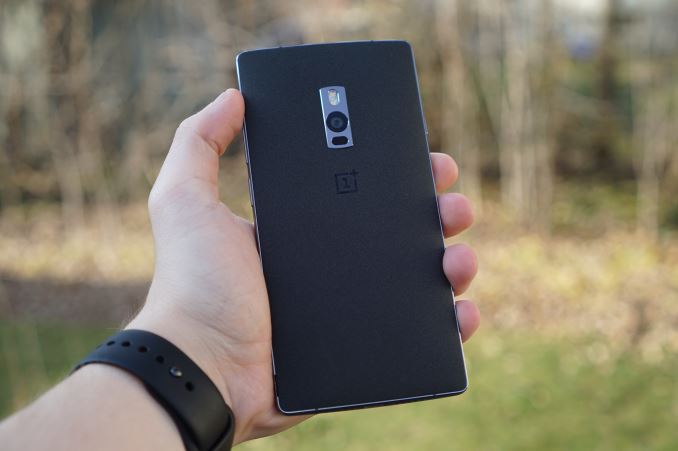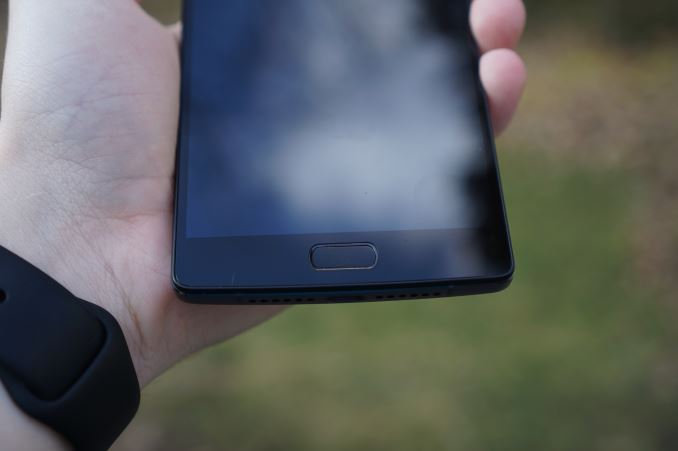The OnePlus 2 Review
by Brandon Chester on December 14, 2015 8:00 AM EST- Posted in
- Smartphones
- Mobile
- OnePlus
- OnePlus 2

In early 2014, there was a lot of excitement among Android enthusiasts for an upcoming smartphone called the OnePlus One. The company producing it was a Chinese manufacturer, and they were a new entrant to the smartphone space. OnePlus's marketing campaign was structured to generate excitement over the prospect of receiving similar specifications to a high end smartphone in a device that was priced substantially lower. Once the device launched, it was clear that OnePlus had delivered on that promise in many respects. The performance and display quality were superb for a $300-350 device, but parts of the software and the camera processing were somewhat lacking.
While the OnePlus One wasn't perfect, there really aren't any smartphones that are. For $300-350, it certainly offered users shopping on a budget a lot of power for their money. With many aspects of the phone already being executed well, one would expect that OnePlus's next phone would serve to iron out the issues and improve on some of the original's failings. That brings us to 2015, with the OnePlus 2 serving as the next flagship smartphone from OnePlus. In many ways it's similar to its predecessor, but with over a year between releases, and a change from CyanogenMod to OnePlus's Oxygen OS, there are certainly a number of changes as well. You can view a comparison of the OnePlus One and OnePlus 2 in the chart below.
| OnePlus One | OnePlus 2 | |
| SoC | Snapdragon 801 2.5 GHz Krait | Snapdragon 810 1.8 GHz A57/A53 |
| RAM | 3GB LPDDR3 | 3/4GB LPDDR4-1555 |
| NAND | 16/64GB NAND | 16/64GB NAND |
| Display | 5.5” 1080p IPS |
5.5” 1080p IPS |
| Network | 2G / 3G / 4G LTE (Category 4 LTE) | 2G / 3G / 4G LTE (Category 6/9 LTE) |
| Dimensions | 152.9 x 75.9 x 8.9mm, 162g | 151.8 x 74.9 x 9.85mm, 175g |
| Camera | 13MP Rear Facing (Sony IMX214) f/2.0, 1.1 micron 1/3.06" sensor | 13MP Rear Facing w/ OIS and laser AF, f/2.0, 1.3 micron 1/2.6" sensor |
| 5MP Front Facing | 5MP Front Facing | |
| Battery | 3200 mAh (12.16 Whr) | 3300 mAh (12.54 Whr) |
| OS | Android 4.4 w/ CM11S (At Launch) | Android 5.1 w/ OxygenOS (At Launch) |
| Connectivity | 1x1 802.11a/b/g/n/ac + BT 4.0 (WCN3680), USB2.0, GPS/GNSS, NFC |
802.11a/b/g/n/ac + BT 4.1, (QCA6164A) USB-C, GPS/GNSS |
| Fingerprint Sensor | N/A | Touch |
| SIM | 1x MicroSIM | DSDS NanoSIM |
| LTE Bands | Global: 1/3/4/7/17/38/40 | US: 1/2/4/5/7/8/12/17 EU: 1/3/5/7/8/20 |
| Launch Price | $299 (3GB/16GB) $349 (3GB/64GB) |
$329 (3GB/16GB) $389 (4GB/64GB) |
When looking at the specs of the OnePlus 2 one can definitely see a similarity between it and the OnePlus One. Both devices have 5.5" 1080p IPS displays, come with either 16 or 64GB of NAND, have a 13MP rear-facing camera with OIS, and ship with Qualcomm's latest SoC. In the case of the OnePlus 2, the SoC moves from Snapdragon 801 to 810, and with that we see a move to LPDDR4 DRAM along with an additional gigabyte of RAM in tow on the 64GB model. The battery capacity receives a slight bump as well, but this is also accompanied by an increase in mass and thickness. The camera sensor has been increased in size, from a 1/3.06" format to a 1/2.6" format. As for the other changes, there's improvement to both cellular and WiFi networking, the inclusion of a fingerprint scanner, and of course, a $30/40 increase in starting price for the 16/64GB models respectively.
Design
The OnePlus One had some unique design attributes that allowed it to stand out from the other devices on the market. Probably the most significant was the back cover, which sported a highly textured feel which one could describe as being like a very fine type of sandpaper. The OnePlus 2 retains many of these traits, but also adds to the design in other ways such as the use of metal for the frame around the device instead of plastic.
Starting with the back cover, you get the same sandpaper-like finish as the OnePlus One. The back cover is actually removable, but it's fit extremely well to the back of the device so you don't get highly visible seams. This means that it is a bit difficult to remove, and I had to slide a sim ejector between the one visible gap in order to start prying it off. While it is connected very tightly, the use of little plastic tabs to hold it on makes me a bit concerned about longevity if you remove the back cover too many times. The Galaxy Nexus used a similar mounting system and I recall seeing phones where one or two of the tabs had broken off which prevented it from attaching properly.
One you remove the back cover you'll see that you don't actually get a removable battery. This isn't any different from the OnePlus One, but I've never really understood the point of having a removable back that only serves to access the SIM tray, when you could just make the sim tray accessible from one of the edges of the device. Since the OnePlus 2 is a dual-SIM phone you also get an interesting little SIM tray which holds both SIM cards. I personally don't have much use for the dual-SIM feature, but I know there are certain (and major) markets where it's absolutely essential so it makes a great deal of sense for OnePlus to include it.
As for the appearance and feel of the back of the phone, I'm honestly not a huge fan. For me the textured back is interesting, but it's not really very pleasing to hold in the hand, and there's just something about how my palm rubs against it that gives me shivers. The little island for the camera, flash, and IR sensor also hasn't been designed with much thought. Considering the flash and IR sensor are almost the same size, I don't understand why OnePlus decided to put them in different orientations instead of making the entire arrangement symmetrical in its appearance. Something about the lack of edge space on the sides of the camera lens looks a bit off as well, although I find it difficult to articulate exactly why it seems that way.
On the bottom of the phone you'll find a set of drilled holes with a USB Type-C port sitting between them. I've said this in all of my other reviews of devices that use USB Type-C, but the transition has to happen eventually and while it's unfortunate that you won't be able to use existing Micro-B cables, it's worth it in the end.
Looking at the other sides of the phone one will see that the right side is home to the sleep/wake button and the volume rocker, while the left has a 3 stage mute switch. The three positions correspond to the three settings for Android notifications, and it's interesting that only OnePlus and Apple include a hardware switch to switch the mute status on their phones. The top of the phone is fairly featureless, aside from a 3.5mm audio jack.
Moving on to the front of the phone we find that it's dominated by the display, with minimal bezel on the top and bottom. Despite this, OnePlus has managed to implement capacitive buttons, a fingerprint scanner, and all without having to move the USB port such that it would be misaligned. The capacitive keys don't have any icons apart from an illuminated horizontal line, but by default they follow the same layout as the standard on screen keys that you'd find on other phones. On the top you have the earpiece and the front facing camera.
In the end, I think from a fit and finish standpoint the OnePlus 2 is actually a pretty good device. It does feel solid in the hand, there's no gaps or flex between the back cover and the rest of the phone due to how it attaches within the edges of the frame instead of onto them, and overall it just feels like a sturdy and substantial phone. As for the design, there are definitely some questionable choices that have been made such as the camera island on the back, and I am definitely not a fan of the back cover material. It's certainly unique though, and if you don't mind the back cover material you'll be getting a pretty solidly built device with the OnePlus 2.













132 Comments
View All Comments
lucam - Monday, December 14, 2015 - link
Hahaha...lol!!!cuex - Monday, December 14, 2015 - link
Is it possible for you to give review using a custom kernel that allow the usage of A57 Cores in normal usage? Would like to know whether it's really the "hesistant of using A57 Cores" is the cause of slow-down...danielfranklin - Tuesday, December 15, 2015 - link
Yes you can, i have and its very fast.In fact ive calibrated my display as well and im quite impressed with it now, the high contrast really comes alive.
Unfortunately with further hacking OnePlus havent properly released their source code and Devs are leaving it in droves.
Im quite happy with it (got it on special) but i cant help but think they have alienated the power users with the lack of code and alienated the normal users with the CPU performance and lack of calibration on the screen.
Personally i think they have kind of lost the plot.
adityarjun - Monday, December 14, 2015 - link
Umm, sorry to hijack this thread but I am in the market for a 5inch-ish android phone. My requirements are a good battery and camera and a decent enough display and lag free UI interaction. I don't game. My current phone is Moto G 2014. I am looking at the 5x, OnePlus X and Moto X 2014. I favor the last. Is it still a good buy?mcbhagav - Monday, December 14, 2015 - link
IMO, if you are dead set on 5" screen. You should get Nexus 5X ( i suggest 32 GB) out of above 3 contenders. Why not one Plus X? HW, SW, Radio are slower than 5X. Why not Moto X-14? smells already end of life.grayson_carr - Monday, December 14, 2015 - link
Wow, I was kind of shocked by the display analysis. I actually owned a OnePlus 2 for a short time way back in August and thought the display looked quite accurate. Granted, I was just using my eyes to compare it to my wife's iPhone 6 and my MacBook Pro and not a measurement tool, but it certainly seemed more accurate than the Nexus 6 and LG G4 which I also had at the time. But maybe I was just looking for oversaturation inaccuracies and not general innacuracies. Also, their website has this quote: "We focused on producing professional grade, true-to-life colors, avoiding over-saturation." (https://oneplus.net/2/technology) But Brandon also mentions that they keep changing the calibration profile with updates, so maybe the calibration has actually gotten worse since I owned it haha. I remember that happening with my OnePlus One... with one of the updates to that phone the color temperature went from like 6300K to 8000K.Bottom line, these little issues are why I ended up selling both my OnePlus One and OnePlus 2 after a very short time. I am a phone nerd and love to try different phones, but I think I'm done giving OnePlus chances to impress me only to be disappointed with the software and abundant other minor annoying issues that add up. I'm not sure how it is now, but when I owned the OnePlus 2 back in August the software was super buggy.
I currently own a Nexus 5X and I would highly recommend it over the OnePlus 2. Don't let the theoretically better specs of the OnePlus 2 fool you. I am having a vastly better end user experience with the 5X even though it doesn't match up spec wise.
zeeBomb - Tuesday, December 15, 2015 - link
Oh definitely. Very cautious move you have done there Grayson. To me, Oneplus has been slipping in terms of...what's the word...I guess presentation for what they have to offer.zeeBomb - Tuesday, December 15, 2015 - link
Take the One Plus X, another device that they had made this year. On paper the specs seem really good for the price you are getting it for... Then you realise it uses a modified 801AA chip plagued with bugs and sluggish graphical performance. I hope in the future Oneplus can fix these things so the user experience isn't such a hassle. At least the updates are quick enough.Another thing that seems to not be mentioned is the USB C cables. They were so cheap to buy, but little that we knew until the faithful Benson Leung came along is the resistor type was way incorrect, which makes charging the device pretty dangerous!
Granted to sum up Oneplus this year: You win some, you lose some.
sandy105 - Tuesday, December 15, 2015 - link
Where did you read about the 801AA and its graphics performance issues ? . I have the OPO and the 801 does well on most games , but i saw a oneplus X review where game performance was sun optimal and it got me thinking why did it happen.zeeBomb - Tuesday, December 15, 2015 - link
Oneplus forums say it all.